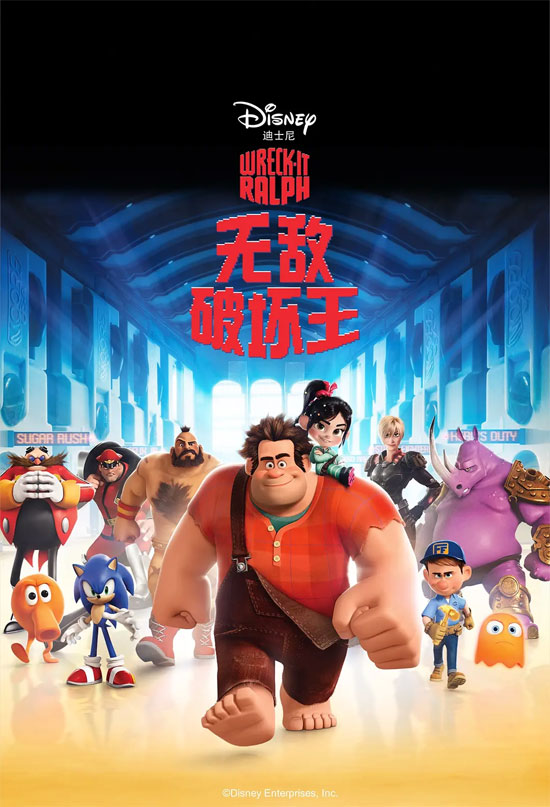Film Name: 无敌破坏王 / Wreck-It Ralph

No time for long reviews? Check out these short ones instead.
——————
· This is the best animated film of the year—it’s practically guaranteed to win next year’s Oscar for Best Animated Feature!
· The film’s theme revolves around discovering one’s own value and purpose.
· The protagonist only traverses two games, which leaves you wanting more.
· The opening scene features an extremely bloody and violent shot that might be unsuitable for children.
· The film’s subtle commentary on monarchy versus presidential systems is a standout highlight.
· It blends Monsters, Inc.’s unique take on the mysterious world behind ordinary things with Toy Story’s imaginative origins.
· Wreck-It Ralph shows us that Disney and Pixar have essentially merged. Add Brave Story to the mix, and it’s clear Pixar is becoming Disney, Disney is becoming Pixar—the two are converging.
——————
When Wreck-It Ralph smashed the explosive rock from the volcano’s peak into the soda fountain with his massive fists at the film’s climax, his destruction reached its zenith. Incredibly, every audience member anticipated this act of destruction, revered it, and was profoundly moved by it. They silently cheered him on, their hearts whispering: “Just destroy it already!”
Thus, the film achieves its purpose: it successfully transforms “destruction” from a pejorative into a term of praise, elevates the destroyer from villain to hero, and redefines the meaning of destruction from heinous mischief to creative upheaval that breaks old to build new. Redefining a concept we’ve long known, dismantling it only to rebuild it with universal values that enlighten the world—Disney didn’t just create the character of Wreck-It Ralph; Disney itself has become the ultimate Wreck-It Ralph!
The old Wreck-It Ralph simply destroyed things, leaving him confused: Was he born evil? Was he destined to live in a junkyard, never achieving the respect and friendships Mr. Fixit enjoyed? Unwilling to be isolated and craving admiration, he refused to accept the passive resignation of other video game villains. He began searching for his own purpose.
Of course, throughout this journey, he continued wreaking havoc. He cracked ceilings, smashed friends’ cakes, ruined shooting games, and nearly got his own game canceled. His massive feet crushed candies wherever he walked, leaving chaos in his wake. But when he encountered the little girl known as the “system glitch” in Candy Racing, and witnessed her being bullied and trampled by other game characters, the kindness and sense of justice within him erupted.
So together they built a race car, though the process remained fraught with destruction; they trained together on a track Wreck-It Ralph had “destroyed” into existence—his first act of creation through destruction; and together they prepared to compete. But due to the Candy King’s deception, Ralph sabotaged the very car they’d built to exploit a “system glitch”… You’ll notice that Wreck-It Ralph’s destruction began to serve a purpose. He destroyed to help others, to create something new, to bring happiness to others. When his destruction shifted from aimless or self-serving acts to altruistic ones, he developed the essence of a hero. His destruction transformed from a tool of evil into a weapon of justice.
A particularly humorous scene involves Mr. Fix-It in the dungeon, who can only make the iron bars stronger no matter what he tries—while Wreck-It Ralph unexpectedly becomes the savior. When your heart is filled with love, even destruction can bring happiness. The film reveals that beneath conventional thinking lie hidden truths—such as a person’s identity and their inner brilliance. Only by shattering the frames that blind our eyes and cloud our minds can fresh values emerge. So-called “system glitches” are not glitches at all, and the “Wreck-It Ralph” can be a hero. Winning medals doesn’t guarantee respect; losing them can unexpectedly win people’s hearts. Being surrounded by crowds doesn’t always mean you’re not lonely; but if your heart is filled with love, even living alone in a garbage heap won’t feel lonely, because companionship is always nearby.
The film’s conclusion analyzes the differences between monarchy and presidential systems, conveying a political philosophy central to “Wreck-It Ralph.” The Candy King’s autocracy brings censorship and concealment of truth. Meanwhile, the “system glitch” aspires to be president, shedding her princess attire to return to ordinary clothes—for presidents come from the people and return to them, with all citizens being equal.
Wreck-It Ralph repeatedly declares his hatred for chocolate, recalling how in his own game, he’s always thrown off rooftops into a puddle of mud that resembles chocolate. But in the end, when “System Glitch” and he saved the game world together, they fell into a chocolate pond once more. This time, he declared, “Now I like chocolate.” For this chocolate was no longer the muddy pit that had once consumed him. It was a pond brimming with sweetness—a symbol of his newfound self-worth, the friendships he had forged, and the happiness he had created with his own “destructive” hands.
Please specify:Anime Phone Cases » Wreck-It Ralph 2012 Animation Film Review: Destruction can be filled with love